Olivetti computers
The Olivetti company, an Italian manufacturer of computers, tablets, smartphones, printers and other such business products as calculators and fax machines, was founded as a typewriters manufacturer by Camillo Olivetti in 1908 in the Turin commune of Ivrea, Italy. Olivetti was a pioneer in computer development, starting with the mainframe systems in the 1950s, and continuing into the 1990s with PC compatible laptops and desktops.
History
1950-60s
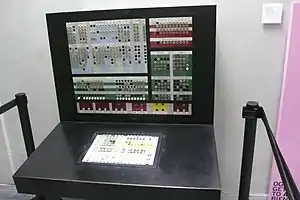
Between 1955 and 1964 Olivetti developed some of the first transistorized mainframe computer systems, such as the Elea 9003. Although 40 large commercial 9003 and over 100 smaller 6001 scientific machines were completed and leased to customers to 1964, low sales, loss of two key managers and financial instability caused Olivetti to withdraw from the field in 1964.
In 1965, Olivetti released the Programma 101, considered one of the first commercial desktop programmable calculators. It was saved from the sale of the computer division to GE thanks to an employee, Gastone Garziera, who spent successive nights changing the internal categorization of the product from "computer" to "calculator", so leaving the small team in Olivetti and creating some awkward situations in the office, since that space was now owned by GE.[1]
1970s
In 1974, the firm released the TC800, an intelligent terminal designed to be attached to a mainframe and used in the finance sector. It was followed in 1977 by the TC1800.
1980s
Olivetti's first modern personal computer, the M20, featuring a Zilog Z8000 CPU, was released in 1982.[2]
The M20 was followed in 1983 by the M24,[3] a clone of the IBM PC using DOS and the Intel 8086 processor (at 8 MHz) instead of the Intel 8088 used by IBM (at 4.77 MHz). The M24 was sold in North America as the AT&T 6300. Olivetti also manufactured the AT&T 6300 Plus, which could run both DOS and Unix.[4] The M24 in the US also was sold as Xerox 6060. The Olivetti M28 was the firm's first PC to have the Intel 80286 processor. The same year Olivetti produced its M10 laptop computer,[5] a 8085-based workalike of the successful Radio Shack TRS-80 Model 100, which it marketed in Europe.[6] These were the first laptops to sell in million-unit quantities, though the Olivetti M10 itself only attained sales figures in the tens of thousands and went out of production within two years.
In 1985, the company acquired a controlling share in the British computer manufacturer Acorn Computers Ltd; a third partner was Thomson SA. Olivetti sold the Thomson MO6 and Acorn BBC Master Compact with brand names Olivetti Prodest PC128 and PC128S[7] respectively.
In 1987, Olivetti introduced the LSX line of computers which was based on the Motorola 68k processor. They could run either MOS or Olivetti's Unix, X/OS.[8]
In 1988, Olivetti released the M380/C, part of the Pandora project - an experimental system for multimedia applications.[9] They also released the PC1 Prodest and PC1 HD (XT clones, similar to the Schneider Euro PC).[10][11]
In 1989, the Olivetti M290S was released, featuring an Intel 80286 at 12 MHz, 1 MB of RAM and a 30 MB hard drive.[12] That same year the company presented their 80486 based next generation of LSX workstations, with the Olivetti LSX 5020 (with EISA-Bus) being shown in CeBit as Computing Platform CP486.
1990s
In 1990, Olivetti had its own distribution network in New Zealand through Essentially Software Ltd.[13] (owned by Gary McNabb) located at Mt. Eden in Auckland and Wellington, where Olivetti M300-100 16 MHz PCs with 80386SX CPU were sold for NZ$7395 and used as graphical work station for design houses using Corel Draw as graphical program. The New Zealand distribution stopped in 1991 when Olivetti could not supply their PCs.
In 1991, Olivetti introduced the D33, a laptop in a carry case and the PCS 286S, a PC with VGA monitor and keyboard.[14] Olivetti also sold quasi-portable 8086/8088-based PCs with an integrated keyboard and one or two integrated 3.5" floppy disk drives, running DOS 3.27, an Olivetti OEM version of PC DOS 3.20 with minor improvements like the M21 portable (based on M24) and the M15. Also later Olivetti produced interesting laptops like M111, M211, S20, D33, Philos and Echos series. A very interesting subnotebook was the Quaderno, about the same size as an A5 paper – it was the grandfather of the netbooks introduced 20 years later.
Olivetti did attempt to recover its position by introducing the Envision in 1995,[15] a full multimedia PC, to be used in the living room; this project was a failure. Packard Bell managed to successfully introduce a similar product in the U.S. but only some years later.
The company continued to develop personal computers until it sold its PC business in 1997.
Models
| Name | Photo | Year | Type | CPU | Created by | Design by | Notes |
|---|---|---|---|---|---|---|---|
| Elea |  | 1957 | Mainframe | Transistor based | Elea series (1957–64). Entirely Transistor based. The Elea 9003 (photo) is the first commercial model | ||
| P101 (Programma 101) | 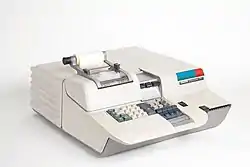 | 1964 | First Personal computer | Transistor based | Pier Giorgio Perotto | Mario Bellini (chassis) | In New York's MoMA . Golden Compass Award. |
| P102 |  | Personal computer | Pier Giorgio Perotto | Version if Programma 101 with at serial connector | |||
| P203 | 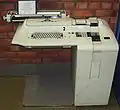 | 1967 | Personal computer | Transistor based | Pier Giorgio Perotto | Mario Bellini | P101 with Tekne 3 and Editor 4. For business, printer included |
| P602 | 1971 | Microcomputer | Integrated circuit | For technical or scientific usage | |||
| P603 | 1972? | Microcomputer | Integrated circuit | P602 with Editor 4. For business. | |||
| P652 |  | 1973 | Microcomputer | Mario Bellini | For technical or scientific usage | ||
| TC800 | 1974 | Mainframe | |||||
| TC1800 | 1977 | Mainframe | |||||
| P6060 | 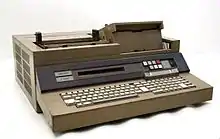 | 1975[16] | Personal computer | PUCE1/PUCE2 TTL |
Pier Giorgio Perotto | Ettore Sottsass and G. Sowden | For technical or scientific usage |
| P6040 | .jpg.webp) | 1975[16] | Personal computer | Intel 8080 | Pier Giorgio Perotto | Mario Bellini | First Olivetti computer to use a microprocessor. For technical or scientific usage. Three versions.[17] |
| P6066 |  | 1975 | Personal computer | Similar to P6060 | Pier Giorgio Perotto | ||
| Olivetti BCS | 1977 | Mainframe |
Business Computer Systems, late 1970s to early 1980s[18] |
||||
| M20 |  | 1982 | Personal computer | Zilog Z8001 4 MHz | Enrico Pesatori, Enzo Torresi and project team[19][20] | Ettore Sottsass
Antonio Macchi Cassia George Sowden |
First Olivetti personal computer in 1982. Own operating system: PCOS. Commercial Failure[21] |
| M10 | 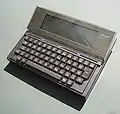 | 1983 | Laptop | Intel 80C85 CMOS at 3 Mhz | Antonio Macchi Cassia
Perry A. King |
First laptop. Present under different brand names: Kiotronic Kc-85, Tandy Trs-80, NEC PC-8201 and Olivetti M10. SMAU Industrial Design prize[22] | |
| M30 | 1983 | Minicomputer | Zilog Z8001 | Linea L1. Operating system COSMOS IV (MOS) | |||
| M40 | 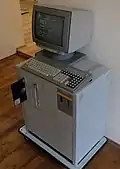 | 1983 | Minicomputer | Zilog Z8001 | Linea L1. Operating system COSMOS IV (MOS) | ||
| M44 | 1983 | Minicomputer | Zilog Z8001 | Linea L1 | |||
| M60 | 1984 | Minicomputer | Zilog Z8001 | Linea L1. Operating system COSMOS IV (MOS) | |||
| M24 | 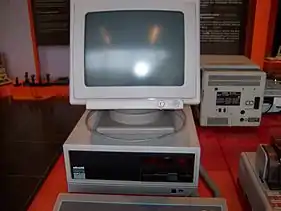 | 1983 | Personal computer desktop | Intel 8086 (16 bit) at 4 Mhz – Optional coprocessor 8087 | Luigi Mercurio, Sandro Graciotti[19] | E. Sottsass | IBM PC compatible;
First Olivetti MS-DOS compatible computer |
| M21 |  | 1983 | Laptop | Intel 8086 (16 bit) at 4 Mhz – Optional coprocessor 8087 | Portable version of the M24 with an integrated monitor. | ||
| M19 | 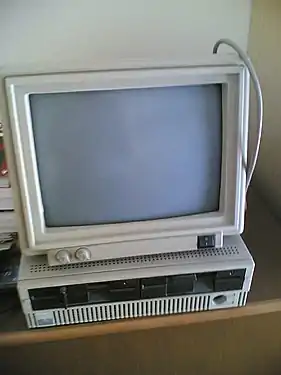 | 1986 | Personal computer | AMD 8088 4,77MHz | Economical model | ||
| M28 | 1986 | Personal computer | Intel 80286 8MHz | ||||
| M70 | 1986 | Minicomputer | Zilog Z8001 | Linea L1. Operating system COSMOS IV (MOS) | |||
| Prodest PC 128 | 1986 | Home Computer | Motorola 6809e 1 MHz | Rebranded Thomson MO6, first on the Olivetti Prodest series.[20] | |||
| M15 | .jpg.webp) | 1987 | Laptop | Intel 80C88 4,77MHz | Removable keyboard. First laptop. | ||
| Prodest PC 128s | 1987 | Home Computer | MOS 6512 2 MHz | Sold as the BBC Master Compact outside of Italy,[23] second in the Olivetti Prodest series.[20] | |||
| Prodest PC1 | 1988 | Home Computer | NEC V40 4.77-8 MHz, XT clone | Third in the Olivetti Prodest series.[20] | |||
| M200 | 1988 | Personal computer | NEC V40 8 MHz | Parallel project to the ETV 2700 typewriter | |||
| M240 | 1984 | Personal computer | Intel 8086 8 MHz | ||||
| M280 | 1986 | Personal computer | Intel 80286 12 MHz | ||||
| M290 | 1984 | Personal computer | Intel 80286 12 MHz | [20] | |||
| M380-40 | 1991 | ||||||
| M24 NEW P133 | 1996 | ||||||
| M380/C | 1988 | proprietary "Pandora" OS[20] | |||||
| M380 | 1988 | Personal Computer | Intel 80186 | Model 380/C[20] | |||
| 1988 | Intel 80386DX 20 MHz | Model XP1 and XP5 | |||||
| 1989 | Intel 80386DX 25 MHz | Model XP7 (tower) | |||||
| 1990 | Intel 80386SX 33 MHz | Model XP9 (tower) Operating system SCO Xenix | |||||
| PE28 | 1988 | ||||||
| M111 | 1989 | Laptop | NEC V30 10 MHz | Mario Bellini
Bruce Fifield |
Operating system DOS 3.30 | ||
| M260s | 1989 | Personal computer | Intel 80286
12 MHz (16 bit) |
Parallel project to the ETV 4000s typewriter | |||
| M290S | 1989 | [20] | |||||
| P500 | 1989 | ||||||
| M386-25 | 1990 | ||||||
| PCS 386SX | 1991 | ||||||
| PCS 86 | 1990 | Personal computer | NEC V30 10 MHz | ||||
| PCS 286 | 1991 | Personal computer | Intel 80286 12,5 MHz | [20] | |||
| M211 | 1989 | Laptop | Intel 80286 | Operating system Windows 3.0 | |||
| M250 | 1989 | Personal computer | Intel 80286 8 MHz | The 250-E model was clocked at 12 MHz | |||
| CP486 | 1989 | Personal computer | Intel 80486DX 25 MHz | Tower, EISA, "Computing Platform" | |||
| P800 | 1990 | Personal computer | Intel 80486DX 25 MHz | Tower. Olivetti MS-DOS 5.00, MS Windows 3.1 | |||
| LSX | 1987 | Personal computer | Motorola 68k | ||||
| LSX 3005 | 1987 | Personal computer | Motorola 68k | ||||
| LSX 3010 | 1987 | Personal computer | Motorola 68k | ||||
| LSX 3015 | Personal computer | Motorola 68k | |||||
| LSX 3018/BS | Personal computer | Motorola 68k | |||||
| LSX 3020 | 1987 | Personal computer | Motorola 68k | ||||
| LSX 520 | 1989 | Personal computer | Motorola 68k | ||||
| LSX-5010 | 1991 | Personal computer | Motorola 68k | ||||
| LSX-5015 | 1991 | Personal computer | Motorola 68k | ||||
| LSX-5020 | Personal computer | Motorola 68k | |||||
| LSX-5030 | Personal computer | Motorola 68k | |||||
| PC PRO 486/33 | 1991 | ||||||
| PC PRO 290SP | |||||||
| M400-40 | 1992 | ||||||
| M6-460 Suprema | 1994 | ||||||
| M290-30 | 1988 | [24][25] | |||||
| M480 | 1990 | Personal computer | Intel 80486SX 20 MHz | Model M480-10 (EISA) | |||
| Intel 80486SX 33 MHz | M480-20 (EISA) | ||||||
| Intel 80486DX 33 MHz | M480-40/60 (EISA) | ||||||
| M316 | 1991 | Laptop | Intel 80386SX 16 MHz | ||||
| M300 | 1988 | Personal computer | Intel 80386SX 20 MHz | Model M300-02 | |||
| Model M300-30 | |||||||
| Model M300-04 | |||||||
| Intel 80386SX 20 MHz | Model M300-10 | ||||||
| Intel 80486 25/50 MHz | Model M300-28 | ||||||
| LSX-5030 | 1992 | Personal computer | Intel 80486DX 33 MHz | Tower, EISA | |||
| S20 | 1991 | Laptop | Intel 80386SX 16 MHz | (Triumph Adler Walkstadtion 386SX | |||
| D33 | 1991 | Laptop | Intel 80386 33 MHz | (Triumph Adler Walkstadtion 386 | |||
| Quaderno | 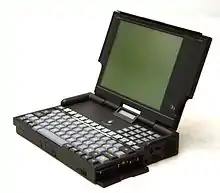 | 1992 | Netbook | NEC V30HL 16MHz | Mario Bellini
Hagai Shvadron |
precursor to the netbooks[26] 1992, 25th SMAU Industrial Design Prize (Italia)
1993, IF Auszeichnung fur gutes Design | |
| Philos |  | 1992 | Laptop | photo | |||
| Echos | 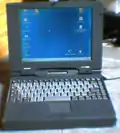 | 1995 | Laptop | Intel Pentium I 75MHz Socket 5 | P75 and P100d | ||
| Envision | 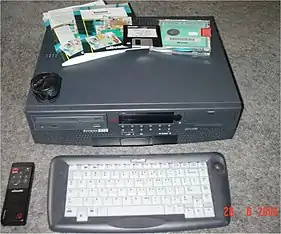 | 1995 | Multimedia | Intel Pentium I 75MHz Socket 5 | Michele De Lucchi | Model P75. Innovative product but commercial failure. Proprietary multimedia OS[20] | |
| M4 |  | 1992 | Personal computer | Intel 80486 SX 25 MHz | M4-M40 | ||
| 1992 | Pentium 75 MHz | M4-M464 | |||||
| 1993 | M4-P75 | ||||||
| 1996 | Intel Pentium-S 75 MHz | M4-P75S | |||||
| 1996 | Intel Pentium 100 MHz | M4-P100 | |||||
| M8500 |  | 1999 | Personal computer | Intel Pentium III 500 MHz | DT desktop, MT minitower |
Peripherals
- PR40, PR2, PR2-e, PR2+, PR2-10 Scanner Printer which was used in banking sectors
- PG-series and PGL-series - black and white digital printers
- d-Color p-series color digital printers
- A3 and A4 series MFP
See also
- Macchine per scrivere della Olivetti : the list of every model of Olivetti typewriter and related article on the Italian Wikipedia
- Olivetti S.p.A.
- Olivetti typewriters
References
- "Programma 101 Memory of the Future: Quando Olivetti Inventò il PC" [When Olivetti invented the PC] (Google You tube). History Channel (in Italian). June 26, 2011.
- "Olivetti M20 D - Computer - Computing History". Computinghistory.org.uk. Retrieved 11 November 2021.
- "Olivetti M24 - Computer - Computing History". Computinghistory.org.uk. Retrieved 11 November 2021.
- InfoWorld (Google Books). 1986-12-01. Retrieved 2012-03-10.
- "Olivetti M10 - Computer - Computing History". Computinghistory.org.uk. Retrieved 11 November 2021.
- "The Olivetti M10". Yet Another Computer Museum. fjkraan.
- "Olivetti Prodest PC 128S - Computer - Computing History". Computinghistory.org.uk.
- "Uncle Miod's machineroom". Retrieved 2012-12-02.
- "Olivetti M380/C (Pandora Project) - Computer - Computing History". Computinghistory.org.uk. Retrieved 11 November 2021.
- "Olivetti PC1 Prodest - Computer - Computing History". Computinghistory.org.uk. Retrieved 11 November 2021.
- "Olivetti Prodest PC1 HD - Computer - Computing History". Computinghistory.org.uk. Retrieved 11 November 2021.
- "Olivetti M290S - Computer - Computing History". Computinghistory.org.uk. Retrieved 11 November 2021.
- Software spectrum acquires Australia, New Zealand supplier of PC... (article), The free library.
- "Olivetti - Company - Computing History". Computinghistory.org.uk. Retrieved 11 November 2021.
- "Olivetti Envision". Ultimate Console Database. Retrieved 2012-03-10.
- "Un computer su ogni scrivania: la Olivetti and i primi PC". Retrieved 4 September 2020.
- "Olivetti P 6040, 1977". Retrieved 4 September 2020.
- "Olivetti Company Computing History". computinghistory.org.uk. November 11, 2021.
- Emilio. "L'avventura Olivetti". Retrieved 16 September 2020.
- "Olivetti - Company - Computing History". www.computinghistory.org.uk.
- "OLIVETTI M 20, 1981". Retrieved 4 September 2020.
- "OLIVETTI M 10, 1983". Retrieved 4 September 2020.
- "Italian Compact set for success". Acorn User. November 1986. p. 7. Retrieved 5 September 2020.
- "Olivetti M290-30".
- https://www.ardent-tool.com/Olivetti/Docs/service_guide/systems1/cap22.pdf
- Quaderno vs EeePC Archived 2015-12-10 at the Wayback Machine Olivetti Quaderno images
| Wikimedia Commons has media related to Olivetti computers. |